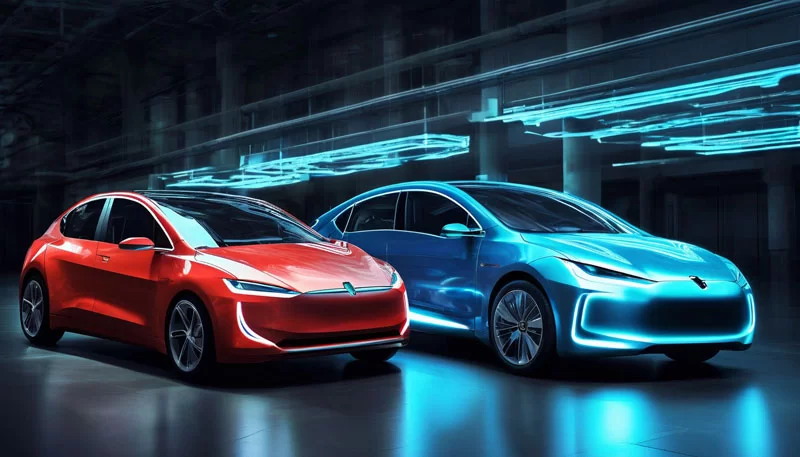Introduction to Emission-Free Vehicles
In recent years, the automotive industry has witnessed a significant shift towards emission-free vehicles, largely driven by the pressing need to address climate change and reduce urban pollution. Traditional combustion engine vehicles contribute substantially to greenhouse gas emissions and air quality degradation, necessitating a transition to cleaner alternatives. Emission-free vehicles, such as electric vehicles (EVs) and hydrogen fuel cell cars, present viable options for consumers who are increasingly concerned about their environmental impact.
Electric vehicles, powered by rechargeable batteries, have gained popularity due to their ability to produce zero tailpipe emissions. As advancements in battery technology continue to enhance their range and reduce charging times, EVs offer a practical solution for daily commuting and long-distance travel. Furthermore, many countries are investing in charging infrastructure, making it easier for consumers to transition to electric driving. The availability of a diverse range of models, from compact cars to larger SUVs, allows potential buyers to find an emission-free vehicle that suits their individual needs and preferences.
Hydrogen fuel cell cars represent another promising avenue for sustainable transportation. These vehicles generate electricity through a chemical reaction between hydrogen and oxygen, with water vapor being the only byproduct. While the adoption of hydrogen fuel cell technology is currently limited by infrastructure challenges and production costs, ongoing research and development efforts aim to make this technology more accessible and affordable for consumers.
The significance of adopting emission-free vehicles extends beyond individual consumer choices; it also encompasses broader societal benefits such as improved air quality, reduced reliance on fossil fuels, and a commitment to combating climate change. As technology continues to innovate and evolve, the future of transportation holds the potential for sustainable solutions that align with both environmental goals and consumer expectations. This transition is crucial as we look toward a cleaner, greener future in mobility.
Advantages of Emission-Free Cars
The adoption of emission-free vehicles, particularly electric cars, presents a multitude of benefits that are gaining increasing recognition among consumers. One of the primary advantages is the significant cost savings associated with both fuel and maintenance. Unlike traditional combustion engine vehicles, which rely on gasoline or diesel, emission-free cars utilize electricity, often resulting in dramatically lower fueling costs. Additionally, electric vehicles (EVs) require less frequent maintenance, as they do not have complex components like oil filters or exhaust systems that require regular servicing. This reduction in maintenance not only saves money but also minimizes the time spent on repairs.
Further incentivizing the transition to electric vehicles are various government incentives designed to encourage sustainable transportation. Many countries offer tax credits, rebates, and grants to promote the purchase of emission-free cars, making them more financially attractive. These incentives can significantly reduce the initial purchase price, thus allowing a wider range of consumers to consider emission-free options as viable alternatives to traditional automobiles.
In addition to economic advantages, emission-free cars provide an enhanced driving experience characterized by the quiet operation of electric motors. Unlike their internal combustion counterparts, electric vehicles function with minimal noise and vibrations, resulting in a serene driving experience. This characteristic not only contributes to driver comfort but also helps reduce noise pollution in urban areas, creating a more pleasant environment for all residents.
From an environmental standpoint, the switch to emission-free vehicles plays a pivotal role in reducing greenhouse gas emissions. As more consumers opt for electric cars, there is a corresponding decrease in the pollutants released into the atmosphere, promoting cleaner air quality. This is particularly crucial in densely populated cities where air pollution has reached concerning levels, impacting public health and quality of life. The cumulative benefits of emission-free vehicles underscore their importance in fostering sustainable urban environments and combating climate change.
Overcoming Common Misconceptions
As the automotive industry shifts toward emission-free vehicles, potential buyers often harbor misconceptions that may deter them from embracing this transition. One prevalent concern is range anxiety, the fear that an electric vehicle (EV) will run out of battery power before reaching a charging station. However, advancements in technology have significantly improved the range of modern electric cars. Many models now boast ranges exceeding 300 miles on a single charge, which is often sufficient for daily commuting and longer trips, alleviating previous anxieties.
Another common worry relates to the availability of charging infrastructure. While early electric vehicles faced challenges due to sparse charging stations, the landscape has changed dramatically. Today, widespread networks of fast-charging stations exist across urban areas and highways. Many cities, as well as various businesses, are increasingly investing in charging installations, making it more convenient for drivers to recharge their vehicles. Studies indicate that most EV owners charge their vehicles at home, reinforcing the idea that daily charging needs are adequately met.
Concerns about resale value are also prevalent among potential buyers. While it is true that the resale market for electric cars is still developing, data shows that many electric vehicles retain their value well, especially as more consumers consider sustainability when purchasing. Therefore, buyers can expect reasonable resale values, particularly for popular models with established track records.
Lastly, some perceive emission-free vehicles as lacking in power or performance. However, electric motors provide impressive torque from a standstill, resulting in an exhilarating driving experience. Numerous electric vehicles have been recognized for their performance capabilities, demonstrating that buyers need not compromise on enjoyment when choosing a zero-emissions vehicle. Thus, addressing these misconceptions can provide potential buyers with greater confidence in transitioning to an emission-free future.
The Future of Emission-Free Car Ownership
The automotive industry is currently undergoing a transformative period marked by significant advancements in emission-free car ownership. As technology evolves, the integration of innovative battery systems plays a crucial role in enhancing the performance and range of electric vehicles (EVs). Manufacturers are investing heavily in research and development to create more efficient batteries that not only improve charging times but also extend the overall lifespan of these power sources. Lithium-ion batteries are continually being refined, and alternatives like solid-state batteries show promise in potentially revolutionizing energy storage and increasing vehicle efficiency.
Moreover, the advent of autonomous driving features is set to redefine the driving experience. With companies actively testing and rolling out semi-autonomous and fully autonomous technologies, consumers can expect a new era of safety, convenience, and driving pleasure. These developments align with emission-free aspirations by optimizing vehicle routes, thereby enhancing energy efficiency and reducing unnecessary emissions. As the market for autonomous electric vehicles expands, we may witness a paradigm shift in car ownership models, including car-sharing and subscription services that prioritize environmentally friendly transport solutions.
The future landscape of emission-free car ownership is not shaped solely by technological advancements but also influenced by changing consumer preferences. There is a growing demand for sustainability, prompting automotive companies to rethink their strategies and practices. Many businesses are adopting green supply chains and prioritizing recyclable materials in vehicle construction. Additionally, government policies and regulations are evolving to support the transition towards more sustainable practices, with incentives for consumers and manufacturers alike. Infrastructure development, including the expansion of charging networks and renewable energy sources, is also critical in fostering a conducive environment for emission-free vehicles. As we look forward, the combined forces of innovation, consumer demand, and supportive policies will pave the way for a more sustainable automotive future.


No responses yet